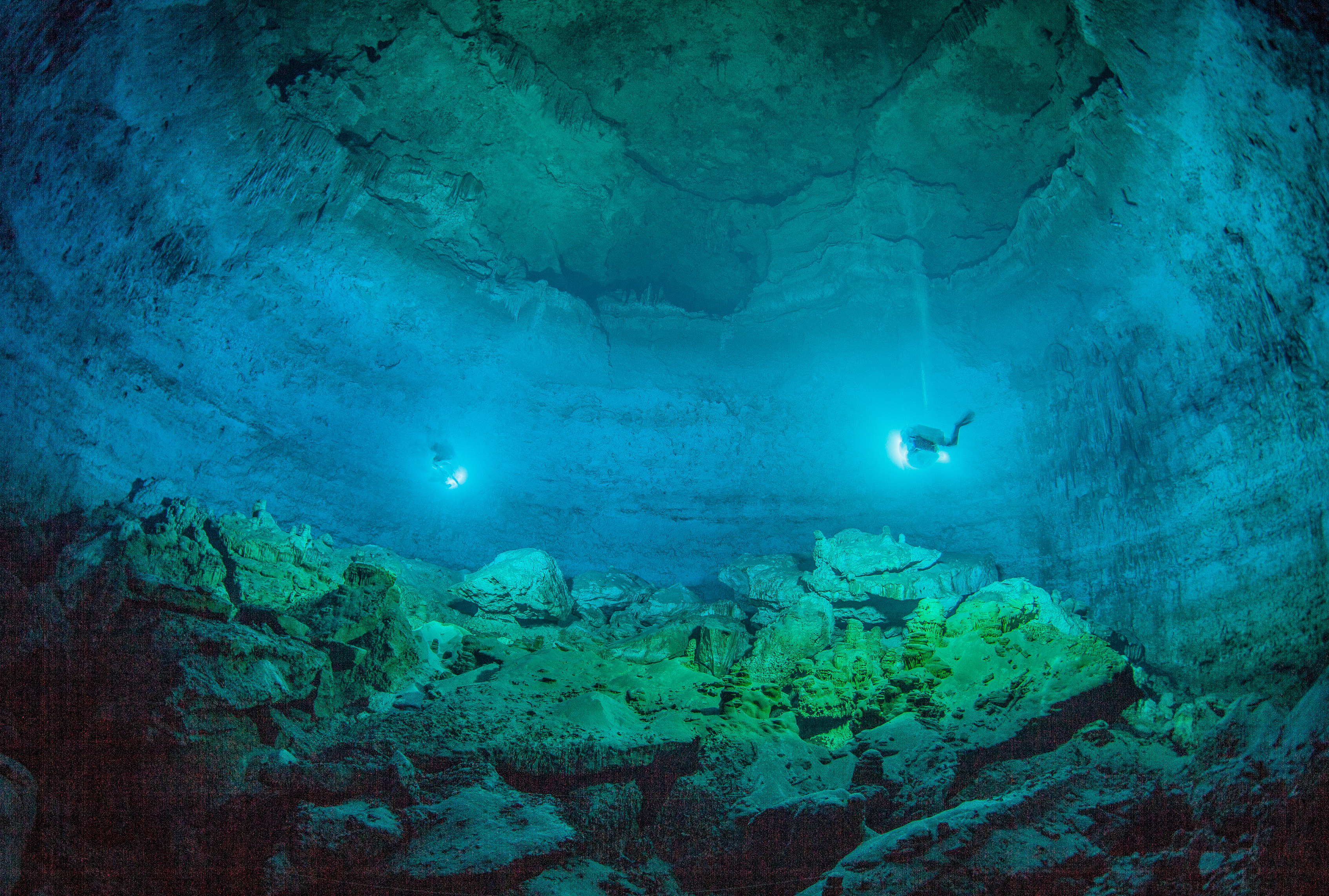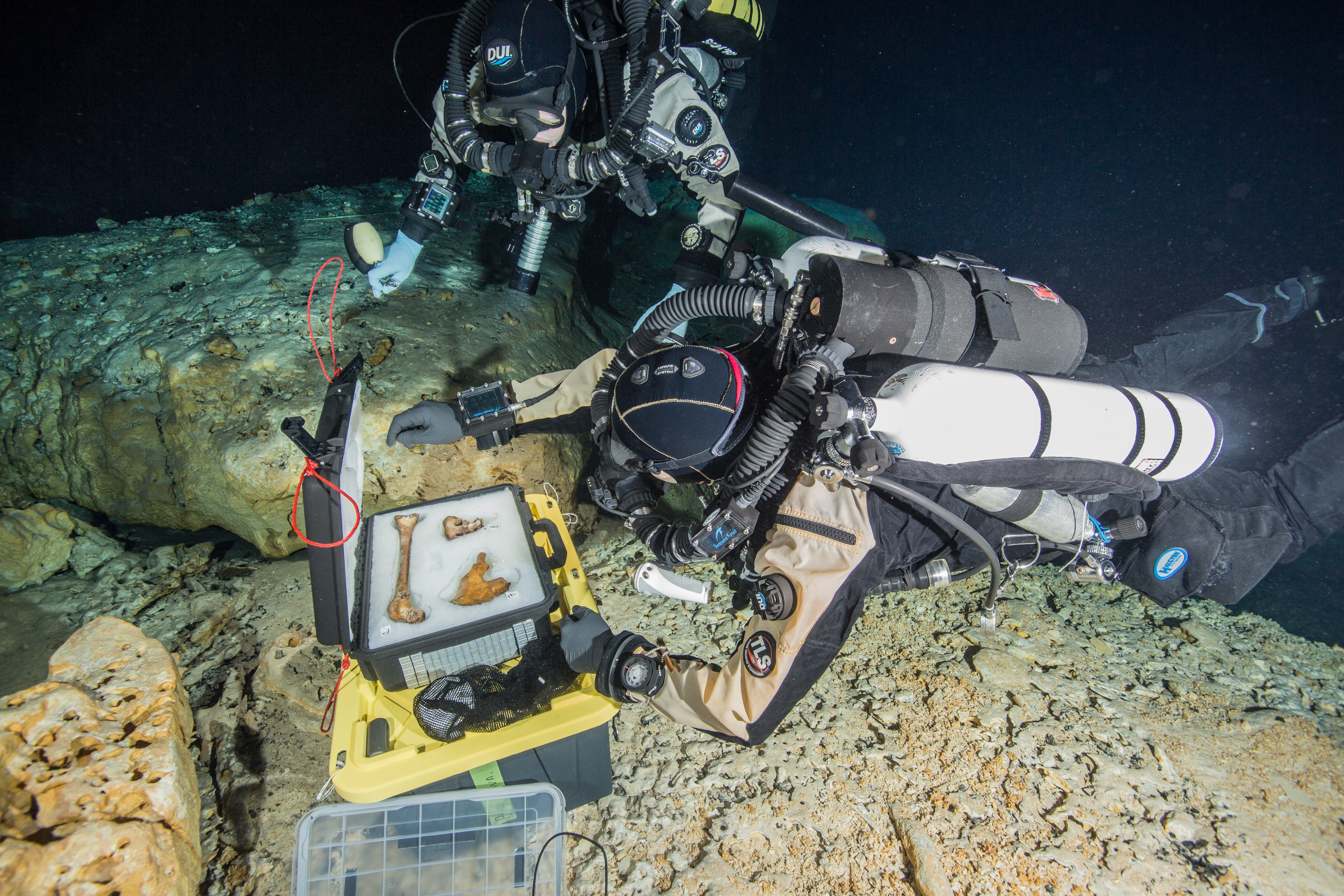墨西哥尤卡坦半岛尼格娄水下岩洞的考古探索
Proyecto Arquelogico Hoyo Negro, Quintana Roo, Mexico
詹姆斯·查德斯 James C. Chatters
毕莱·茹娜·艾丽娜 Pilar Luna Erreguerena
(墨西哥国家人类学和历史学研究所 National Institute of Anthropology and History, Mexico)
美洲考古研究的三个基本问题是:“智人何时到达西半球?”,“他们通过什么路线迁移到冰川南部”以及“他们对该地区多样化的巨型动物有什么影响?”这些问题引发了激烈的讨论。一些学者认为那些创造了克洛维斯文(开始于距今11400到11060之间)的人群是最早到达的,而另一些学者则认为前克洛维斯文化可以早到距今17000年。一方认为最早的移民是通过冰川间的大陆内部进入的,而越来越多的人则认为存在太平洋沿岸的进入路线。一方认为有超过80种大型哺乳动物的灭绝要归因于或至少部分归因于猎人,而另一方则认为广义的狩猎采集者在半球生物多样性的大幅下降中不起作用或者所起作用甚微。

这些争论旷日持久是因为证据大多数是间接的。存在于更新世末期太平洋沿岸线路如今几乎全部被淹没于水下;在所谓的走廊上的考古发现少之又少并且年代也不确定。有关前克洛维斯的发现其年代几乎都不确定,并且都为与人类有关的遗物。克洛维斯文物分布普遍,从加拿大中南部到委内瑞拉北部无处不在,但是除了发现少数几处对猛犸象、乳齿象和嵌齿象以及马和美洲骆驼的杀戮之外,它们都很少发现有动物遗存。在美国东部和中美洲,这些遗址几乎没有发现骨头遗存。人类遗存可以提供有关人类行为、饮食偏好和在食物链中位置的直接证据,因此可以为讨论这类问题提供巨大的帮助,但是直到2007年,仅发现了两组测年为克洛维斯时代的骨头碎片。这包括来自一个婴儿的四个碎片和一个成人的两条腿骨。从未发现有人类遗骸与所谓的他们所导致灭绝的动物遗存共存。

这种情形在2007年开始改变,一队洞穴潜水者Alejandro Álvarez,Alberto Nava和 Franco Attolini 发现了尼格娄水下岩洞,这是萨伽土尼天然水井(世界上最大的水下隧道系统之一)的一处巨大的塌陷室。它直径为60米,深35到55米,位于三条长隧道的交汇处,其地面低于现代海平面10到12米。在末次冰期中,这个系统完全位于水面之上,动物可以从许多天然水井(称为“cenotes”)进入这个系统。距离这个洞穴最近的更新世入口位于600之外,几个世纪以来,许多动物掉进了这个钟形的空间,潜水员在这个天然陷阱的底部发现散落有大型动物的骨骼和一具人头骨。潜水员已经探索了尤卡坦半岛东部洞穴近30年,现在已经绘制了近1500公里的淹没通道。在探索过程中,他们经常看到并拍摄了大型动物的零星骨骼及大型哺乳动物的完整骨骼,包括嵌齿象、巨型地懒、海牛和貘。人类骨骸也很常见,大部分是晚期的玛雅人,但也有一些非常古老的。尼格娄水下岩洞的不同之处在于人骨和动物骨骼共存,并且处于现代海平面40米之下的位置。人骨和一具乳齿象骨骼混在了一起。除了作为古生物宝库之外,地面上有石笋、木炭、树枝、蝙蝠粪便和方解石沉积物。这为详细记录当地的古生态和冰后期海平面上升年代序列提供了可能。
2011年成立了Proyecto Arqueológico Subacuático Hoyo Negro, Tulum, Quintana Roo(黑洞水沟、图伦、金塔纳水下考古项目),属于墨西哥国家人类学和历史学研究所水下考古区,这标志着对黑洞水沟科学研究的开始。该项目是由墨西哥、美国和加拿大的高校和政府机构组成的学者联盟,包括古生物学家,考古学家,体质人类学家,地球化学家,古植物学家,医生和计算机模拟专家。我们的目标是收集人类骨骼并尽最大可能获取更新世末期人类的生存环境。为了实现该目标,我们试图鉴别洞中的每一种动物物种,并通过放射性测年法确定地质年代,并通过稳定同位素分析将其置于当地的食物网络中。此外,我们还需要获取有关海平面变化的数据,以及根据洞穴堆积物和方解石沉积物获取的气候和水文条件。要做到这一点,需要在考古界从未遇到的艰苦环境中工作。
黑洞水沟项目从田野工作和研究视角都遇到巨大的技术挑战,除了上部隧道散落的少量化石之外,该遗址位于超过水下40米的黑暗环境中。直接在沉积物和化石上工作需要技术性潜水和洞穴潜水认证,这是科学家很少拥有的资质。这种严苛的环境意味着科学团队必须依赖有经验的潜水员来帮助完成这项任务。这也意味着洞穴中许多可见的化石不能被安全地收集,对样本的采集必须仔细计划和准确执行。此外,热带岩溶环境和其被水淹的历史对这些样品的测年也构成重大挑战。从最初温暖的淡水到现在的咸水,骨骼在其中至少已浸泡10000年。胶原蛋白几乎没有保存下来,并且骨骼中的磷灰石也经常被洞穴水中的碳酸钙污染。木炭比较常见,但是明显经过反复漂浮和移动,这使得对于确定其下遗存的年代下限几乎毫无用处。

为了应对黑洞水沟所遇到的挑战,在2015-2016年度的考古工作中,我们开始将高分辨率摄影,三维电脑模型和高选择性的采集相结合起来。工作从摄影和建模开始。首先,潜水队在30米深的地方布置了间隔为2米的网格,然后他们对整个地面和部分墙壁以及隧道连接处拍摄了数以千计的可以相互重叠的高分辨率数码照片。加州大学圣地亚哥分校的高通研究所三维建模团队运用Agisoft将这些照片拼合起来,生成了直径60米的地面照片。此外,地面上的每一组动物骨骼都被近距离拍摄从而生成高分辨率的三维模型,这些照片和模型使得考古人员可以分类鉴别标本,对标本进行选择性地采集以及设计标本的复原方法。
现在称为奈阿的15-17岁女性的人体骨骼在2016年的三个潜水季节中完成复原。使用这种模型可以对每个部分进行精确测量并切割成样品以适合采集盒的尺寸。潜水员带着潜水卡进入水中进行采集,潜水卡上附有目标样本的编号照片。卡片上的每个数字都与采集盒相匹配。采集盒在深水下进行密封直到运输到位于300公里之外的坎佩切(Campeche)实验室才被打开。这种预防措施是必要的,因为它可以避免盒中的水来回拍打从而损坏脆弱的骨样。我们总共采集了78个骨骼碎片,包含98个骨骼元素和28颗牙齿。这几乎包含所有的主要骨骼元素,仅仅缺失了脚骨,腿骨的一部分以及一些肋骨、椎骨及手骨。
通过结合牙釉质的放射性碳测年,上覆的方解石铀—钍测年以及海平面变化的年代序列,可以将这些骨骼年代定为距今13000-12000年之间,可能的时间跨度为距今12700-12900。这使得Naia成为美洲历史上经过确切测年的最古老的人类骨骼样本,也是目前在距今11400-10600克洛维斯文化期内唯一一具完整的骨架。作为一个年轻个体,她的骨骼和牙齿记录了她的成长过程以及她孩提时代的移动轨迹。
因此奈阿提供了大量早期时代妇女和儿童生活的信息。尽管她生活在仅距离海岸线7公里的地方,但是她很瘦弱,并且经常患蛋白质缺乏症。这给太平洋沿岸的移民理论带来了新的问题。她的左前臂遭受过螺旋形骨折,在当今这种现象通常和身体遭受虐待联系起来,并且她年纪轻轻就已为人母。我们还有更多关于她这个时代人群的饮食和生活方式的研究,有关这一主题的一篇文章目前正在评审中还尚不能发表。他们提供了有关饮食,捕食策略和迁移模式的相关见解,这些问题将有助于人类在美国大型动物灭绝过程中的作用的争论。
迄今为止,在黑洞水沟地面上已经鉴别出13种哺乳动物(蝙蝠除外),在隧道连接处鉴别出5种。这些包括已经灭绝的7种巨型动物物种:乳齿象,剑齿虎,短面熊,沙斯塔地懒,磨齿地懒,一种与狼相似的大型南美犬科动以及一种目前未知的磨齿地懒。美洲狮、貘、野猪、浣熊、负鼠以及一些未鉴定出的小型猫科动物构成这个动物群。除了骨骼之外,潜水员还在上面隧道发现了短面熊的足迹。这些动物骨骼以前在委内瑞拉以北从未见过,也没有关于它们身体结构和运动模式的信息。因此这些足迹是古生物学记录的重要补充。
在2015年底和2016年,根据三维模型测量数据设计的样品采集盒以及人体骨骼描述程序,潜水队员复原了三只短面熊和一只磨齿地懒的部分骨骼。头骨是采集的首要目标,因为它们对鉴别最有帮助,并且也让我们更易于分析牙本质和牙釉质。一只熊的放射性测年将其置于和Naia相同的地质年代,表明至少有一种巨型动物和她处于同一个时代。树懒是一个新的属,我们已经将其命名为Nohochichak xibalbahkah(发音为shi bal bah kah)。不幸的是,对磷灰石的初步测量表明其年代上限可能距今36000年,所以该动物和Naia并不是同时的。
在第三届世界考古论坛期间,该项工作仍将持续。在2017年11月至12月期间,我们计划收集10多种动物以及一些石笋及方解石附生样本。这一次,最重要的化石样本是剑齿虎,磨齿兽和沙斯塔地懒,以及熊和Nohochichak(地下世界的巨爪生物)的肢骨。来自于该遗址的人类、树懒和食肉动物群的出版物将在来年面世。石笋和方解石样本将会为30000年前的更新世末期提供海平面和气候数据,这将会是从这个遗址已经获取的全新世数据的重要补充。
Three questions at the foundation of Americanist Archaeology are “When did Homo sapiens first arrive in the Western Hemisphere?” “By what route or routes did they migrate south of glacial ice?” and “what impact did they have on the region’s diverse megafauna?” Fierce debates surround each of these questions. Some scholars insist that people who produced the Clovis Culture, which began between 11,400 and 11,060 cal BP were the first arrivals, while others see a pre-Clovis arrival as early as 17,000 cal BP. One camp argues that the first migrants must have entered through the continental interior between glacial ice masses, whereas a growing number insist on a Pacific Coast route of entry. Extinction of more than 80 genera of large mammals is either attributable, at least in part, to human hunters, or generalized human foragers played little or no part in that great decline in the hemisphere’s biodiversity.
One reason these debates persist is that much of the evidence is circumstantial. The Pacific coastline that existed during the terminal Pleistocene is now almost all under water; archaeological finds in the supposed corridor are few and of uncertain age. Pre-Clovis finds are almost all of uncertain age or human association. Clovis artifacts are widespread—in fact almost ubiquitous from south-central Canada to northern Venezuela, but, except for a few major kills of mammoth, mastodon, and gomphothere, and isolated horse and American camel, they are rarely associated with faunal remains. In the eastern US and Central America, bone preservation is almost nonexistent in such sites. Human remains could contribute greatly to this discussion by providing direct evidence of people’s behavior, dietary preference, and position in the food chain, but until 2007, only two fragmentary sets of bones dating to Clovis times had been found. These consisted of four fragmentary elements from an infant and two leg bones of an adult. Human skeletal remains had never been found in association with bones of the animals they supposedly brought to extinction.
That picture changed in 2007, when a team of cave divers, Alejandro Álvarez, Alberto Nava, and Franco Attolini, discovered Hoyo Negro, an immense collapse chamber in the Sac Actun cave system, one of the largest submerged tunnel systems in the world. This 60 meter diameter, 35 to 55-meter-deep chamber lies at the confluence of three long tunnels, the floors of which are at 10-12 meters below modern sea level. During the last glaciation, this system was entirely above water and animals could enter it from the many sinkholes (called “cenotes”) that dot this region. The nearest Pleistocene entry to the cave is 600 meters away. Over the centuries, many animals fell into the bell-shaped chamber. Scattered over the bottom of this natural trap the divers found bones of large animals and the skull of a human. Divers have been exploring the caves of the eastern Yucatan Peninsula for nearly 30 years, having now mapped nearly 1500 kilometers of submerged passages. During their explorations, they have often seen and photographed scattered bones and even complete, articulated skeletons of large mammals, including gomphotheres, giant ground sloths, manatees, and tapirs. Human skeletons are common. Most are from the recent Maya people but a few are thought to be very ancient. What was different about Hoyo Negro was that the bones of people and animals occurred together and were at a depth of more then 40 meters below modern sea level. The bones of the human and one gomphothere were commingled. In addition to being a paleontological treasure trove, the chamber’s floor is dotted with stalagmites, charcoal, tree branches, and cones of bat guano and calcite sediment. These provide the potential for a detailed record of local paleoecology and a chronology of postglacial sea-level rise.
Scientific research on Hoyo Negro began in 2011 with the formation of Proyecto Arqueológico Subacuático Hoyo Negro, Tulum, Quintana Roo (Underwater Archaeology Project Hoyo Negro, Tulum, Quintana), under Mexico’s underwater archaeology area at the Instituto Nacional de Antropología e Historia (National Institute of Anthropology and History). Proyecto Hoyo Negro is a consortium of scholars from universities and government agencies in Mexico, the United States, and Canada. Included are paleontologists, archaeologists, physical anthropologists, geochemists, paleobotanists, physicians, and computer modeling specialists. Our goal has been to collect the human skeleton and to wrest the maximum possible information about terminal Pleistocene environmental conditions humans first encountered. To achieve this we seek to identify each of the animal species in the cave and determine its geologic age by radiometric dating and place in the local food web through stable isotope analysis. In addition, we need to obtain data on changing sea levels, and climatic and hydrological conditions from speleothems and calcite sediment. To do this requires operating in some of the most difficult conditions the archaeological world has to offer.
Hoyo Negro poses significant technical challenges, from both field and analytical perspectives. The site is in the dark and, except for a few fossils scattered in the upper tunnels, it is more than 40 meters under water. To work directly on sediments and fossils requires certification in both technical diving and cave diving, which are qualifications few scientists possess. This restrictive environment means that the scientific team must rely on its skilled divers to be its eyes and hands. It also means that many of the fossils visible in the cave may never be safely collected; collection must be planned carefully and executed flawlessly. In addition, the tropical karst setting and its flooding history pose major challenges for dating the finds. Bones have lain in warm, first fresh and now salt water for at least 10,000 years. Collagen preservation is almost nonexistent and the bioapatite fraction of bones is often contaminated by calcium carbonate in the cave waters. Charcoal is common but has demonstrably been floated repeatedly and moved about, making it next to useless for determining minimum ages of underlying finds.
Hoyo Negro’s challenges were met in the 2015-2016 field seasons using a combination of high-resolution photography, 3-Dimensional computer modeling, and highly selective collecting. Work began with photography and modeling. First, the dive team laid out a grid of lines spaced 2 meters apart across the chamber at a depth of 30 meters. They then took thousands of overlapping high resolution digital photographs of the entire floor and portions of the walls and connecting tunnels. These were stitched together by the 3-Dimensional modeling team at the Qualcomm Institute of the University of California, San Diego, using structure-from-motion software (Agisoft) to create a composite of the 60-meter diameter floor. In addition, each cluster of animal bones on the cave floor is being photographed close up to produce higher resolution 3-Dimensional models. From these photographs and models it has been possible for the archaeological team to taxonomically identify specimens, select specimens for collection, and design mechanisms for specimen recovery.
The human skeleton, that of a 15-17 year-old woman now known as Naia, was recovered in three dive seasons of 2016. Using the 3-Dimensional model it was possible to take the dimensions of each element and cut forms in collection boxes to precisely fit. Divers entered the water with dive cards including numbered photographs of the elements to be collected. Each number on a card matched a slot in a box designed to receive that element. Boxes were sealed at depth under water and kept sealed until opened in the laboratory in Campeche, more than 300 km away. This precaution was necessary to avoid air spaces to allow water to slap back and forth in the boxes and damage the fragile bones. In all, 78 bone pieces, including 98 skeletal elements and 28 teeth were recovered. This includes nearly all of the major elements. Only the feet, part of one leg, a few ribs and vertebrae, and some hand bones are missing.
Dating by a combination of radiocarbon dating of tooth enamel, uranium-thorium dating of overlying calcite formations, and chronology of sea-level change place this skeleton between 13,000 and 12,000 cal BP, with a probable age between 12,900 and 12,700 cal BP. This makes Naia the oldest securely dated human skeleton in the Americas and the only complete skeleton to date within the Clovis culture window of 11,400-10,600 cal BP. As a young person, her bones and teeth documented the course of her growth and her movements across the landscape while she was still a child.
Naia is thus providing extensive information about the lives of women and children at this early time. She was very gracile and often suffered protein deficiency, despite living only 7 kilometers from the coast at the time she died. This brings the Pacific coast migration theory into question. She suffered a spiral fracture in her left forearm of the sort typically associated with physical abuse today and had already been a mother at her young age. We have additional insights to share about the diet and lifeways of her people but these are embargoed pending review of an article on the subject. They provide insights into the questions about the diet, predation strategy and patterns of movement that will contribute to the debates about humans’ part in the extinction of American megafauna.
To date, 13 species of mammal, not including bats, have been identified on the Hoyo Negro floor and 5 in the connecting tunnels. These include 7 extinct megafaunal species: the gomphothere Cuveronius tropicus, sabertooth Smilodon cf fatalis, the short-faced bear Arctotherium, the Shasta ground sloth Nothrotheriops shastensis, a mylodont ground sloth (probably Paramylodon), a large wolf-like South American canid, and a previously unknown species of mylodont sloth. Pumas, tapirs, peccaries, a coati, opossums, and as yet unidentified small cats complete the menagerie. In addition to the bones, divers have found tracks in the upper tunnels belonging to the short-faced bears. Bones of these animals had never before been seen north of Venezuela and no information about body structure or locomotor patterns had been known. The tracks are thus a magnificent addition to the paleontological record.
In late 2015 and 2016, with boxes designed with measurements taken from the 3-Dimensional models and following procedures described above for the human skeleton, the team recovered parts of three short-faced bears and the mylodont sloth. Skulls are targeted primarily because they are the most useful for identification and for the analyses best accomplished with tooth dentin and enamel. Radiocarbon dating of one bear places it in the same geologic time range as Naia, indicating that at least one of the megafauna was probably her contemporary. The sloth is a new genus, which we have named Nohochichak xibalbahkah (the second name pronounced shi bal bah kah). Unfortunately, preliminary dating of bioapatite provides a maximum possible age of around 36,000 cal BP, so this animal was not Naia’s contemporary.
Work is continuing as this Shanghai conference takes place. During the November-December 2017 season, parts of 10 more animals and several stalagmites and samples of calcite overgrowth are scheduled for collection. This time, the most important fossils are the sabertooth, the mylodont and Shasta sloths, and limb bones of the bears and Nohochichak. Publications on the human, and the sloth and carnivore faunas from the site are expected in the coming year. Stalagmites and calcite samples will add to the Holocene record already taken from the site to provide data on sea level and climate for what may be as much as 30,000 years of the terminal Pleistocene.
